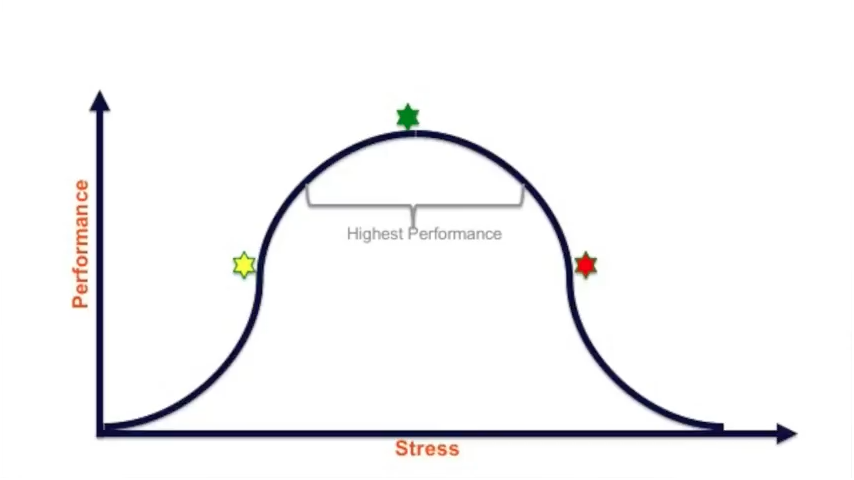Stress Performance Curve – How Stress Makes High Performers Better
Although it sounds counter-intuitive, high performing CEOs and managers actually need stress to be their best. The key is to understand and work in that optimal area of the stress performance curve – where you maximize performance at a level of stress that is manageable for you.
I wanted to share with you one of my favorite quotes from my book Your Oxygen Mask First:
There is no in-between with leadership. It either slowly destroys your life or it forces you to get stronger.
Now, that might not seem like a positive or motivating quote, but it’s the truth. The challenge of building an enduring, great company and doing something amazing in your career is that it takes a big toll on you – and that can be painful; it also could be an absolute blast if you do it right.
Here is another quote from the book about work-life balance, which I think is an absolute silly concept, but here is the way I like to see it:
You don’t go to the amusement park roller coaster, and say, “I want to be balanced.” No, you want to be as unbalanced as possible because that’s the thrill of the ride.
High performers like it when it gets a little bit easy and settles down – to catch our breath – but then we get bored and want to do more. So, this is about making sure there are continual challenges.
Stress Performance Curve

There’s a beautiful model* I have found that helps to illustrate what we’re talking about here. On one axis is the level of performance, and on the other, the level of stress. Maximum performance comes at this intersection of the optimal amount of stress and what works for you (the green dot in the middle).
Now, this chart is not stable: it moves around to the left and to the right. If you go down and see the yellow star, that is safe place, an easy place. There’s not a lot of stress, and there’s also not a lot of performance. It’s just like a race horse.
Race horses needs competitors to run their fastest. They often cannot run their best if they just out there by themselves. If you look at high performers, there’s not enough stress or competition for them to really feel that performance anxiety that brings out their absolute best.
Go for the green
Now, if you look over at the red dot, the red dot is too much. That’s the point where the stress starts to kill the person by destroying them on the inside. They can handle it for a bit, but there’s a point where they need to learn and grow to be able to handle it – or maybe it’s just a situation that’s too much.
As high performing leaders, we want to get in that highest performance zone – right around the green dot – and stay there. Unfortunately, it gets way too much, “Oh my gosh. I feel like I’m gonna die. It’s destroying me,” to not enough and, “I’m bored.”
So, I always ask high performers, or A Players: “Hey, how is your level of challenge?”
If their eyes roll in the back of their head, I know they’re in the red zone. If they’re smiling and engaged, sitting forward, they’re probably in that green zone. And if they’re kind of, “Well, you know, I’m getting kind of restless, looking for another challenge or opportunity,” I know they’re in the yellow. As leaders, our job is to keep pushing them there.
What do you do when they’re in that red place?
Double Your Capacity
This is where the learning, the growth, and the development comes in. If you’re using the same skills you used five or 10 years ago, you won’t be able to handle more stress and challenge. What you need to do is to learn your way out – to keep moving that green dot out, and out, and out, so that your performance level goes up, and the amount of stress and pressure you handle also goes up.
Essentially, that’s what all of the 17 habits are about, in my book – 17 habits to help you to mentally and mechanically handle more pressure and challenge, so that you can rise up to your goals, achieve what you want, and still enjoy the ride.
The key point of all of this is that you need to double your capability every three to five years to deserve the designation of leadership. You do that through growing what you know, who you know – and your own resilience. If you don’t, even if you may want more responsibility, it may start to slowly destroy you, and that’s not fun. Now, if it’s only for a few months, it’s fine – work on some strategies, improve, and get better.
The Challenge
- If you haven’t already, do the Your Oxygen Mask First Self-Assessment.
- Rate yourself on those 17 habits and then figure out which one you need to work on next.
- After you do the assessment, you’ll be directed to videos on each habit – these will help walk you through some detailed action items to follow up on
The final thought I’ll leave you with is for you and your team: If you’re finding people are floundering – where that red dot is, where it’s just too much – go back, and ask the question:
“What do they need to learn or change to be able to rise up to that level?”
Not, “What do we need to do to reduce the pressure?”
Our job is not to give and take more pressure, but to learn better skills to do it.
If you have any questions, leave a question here. All the best.
* This is based on the Yerkes-Dodson law which refers to a relationship between stimulation and performance.